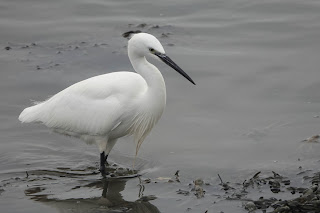 |
| Curlew Numenius arquata with Redshank Tinga totanus in foreground |
Wednesday 15 December
No doubt my friend David Elliott-Binns and his Arboleas Birding Group were almost finished by the time Jenny and I walked across the road to take the footpath upstream alongside the Hamble river, especially as they were an hour ahead of us on the clock and it was almost midday when we set off. Still no rain but calm and cloudy and a relatively mild temperature of around 12C. The tide was on the turn and, strange as it may seem, with a double tide on Southampton Water and high tide at both 7.45 and 10.51, once the tide does turn wet becomes mud flats at a rate of knots with low tide barely three hours later. This means that, in theory, we get the advantage of birds pushed up the beach to ret and freshly-exposed feeding mud within a very short space of time. And so it was this morning when we arrived at the river a few minutes before midday.
 |
| Redshank Tinga totanus |
Immediately on our left both Redshank and Black-headed Gul on the shore before a flock of sixty plus Brent Geese few over our heads towards Southampton Water. For the next hour there was a constant movement of Brent Geese to the main water plus those small groups that remained behind to feed locally. In all we estimated at least 140 individuals. Meanwhile, the occasional Turnstone and more Redshank before the first Curlew and a hunting Little Egret. Further out on the river proper, a couple of Cormorant were diving after fish and a Pied Wagtail was foraging the shore in front of us.
 |
| A very small sample of the over 100 Brent Geese Branta bernicla |
Moving on up the river we soon found the first flock of the wintering Wigeon along with a few Teal and a single Greenshank. A Rock Pipit was found by Jenny and although it moved off after a quick photo it was found again on the return journey. On a muddy island just off shore a large gathering of Dunlin plus at least five Grey Plover were seen feeding.
 |
| Rock Pipit Anthus petrosus |
At the back of the marsh we watched a pair of Mallard fly westwards and in a large garden a group of fourteen Canada Geese were grazing. Just to their left a Magpie was also searching the ground. Now the first Carrion Crows arrived on site and a very distant Heron was found hiding in the tall grass.
 |
| Grey Plover Pluvialis squatarola |
So on to the conservation area where another large mixed group of Wigeon and Teal were resting and awaiting the the receding tide. As well as a few Black-headed a single adult Herring Gull was also observed along with trio of Feral Pigeons.
 |
| Herring Gull Larus argentatus |
With the green meadow now exposed as the water departed, a couple of Oystercatchers and a single Shelduck arrived on the scene. To or right in a small inlet a Little Grebe was busy diving and feeding. Nearing the end of the return walk a look at the the far trees bordering the houses produced both Starling and Wood Pigeon to end our morning's birding with a final tally of 28 species.
 |
| Oystercatcher Haematopus ostralegus |
Birds seen:
Brent Goose, Canada Goose, Shelduck, Wigeon, Mallard, Teal, Little Grebe, Cormorant, Little Egret, Heron, Oystercatcher, Ringed Plover, Grey Plover, Dunlin, Black-tailed Godwit, Curlew, Redshank, Greenshank, Turnstone, Black-headed Gull, Herring Gull, Feral Pigeon, Wood Pigeon, Rock Pipit, Pied Wagtail, Magpie, Carrion Crow, Starling.
 |
| Dunlin Calidris alpina |
 |
| Black-tailed Godwit Limosa limosa |
 |
| Greenshank Tringa nebularia |
 |
| Little Egret Egretta garzetta |
 |
| Brent Geese Branta bernicla |
 |
| Common Teal Anus crecca |
 |
| Wigeon Anas penelope |
Check out the accompanying website at http://www.birdingaxarquia.weebly.com for the latest sightings, photographs and additional information














No comments:
Post a Comment